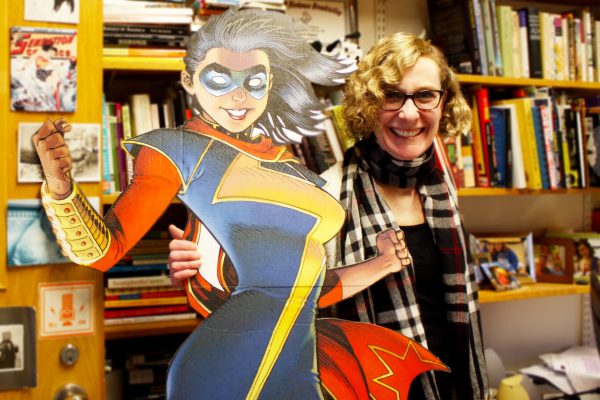Jessica Baldanzi, associate professor of English, has a unique passion: comic books and graphic novels. Her affection for this form of creativity started in her childhood with works like Betty and Veronica and Richie Rich. However, she became seriously invested in comics and graphic novels during graduate school at Indiana University Bloomington.
“I was a student assistant for Susan Gubar, a feminist scholar, and part of her syllabus was Art Spiegelman’s Maus,” Baldanzi said. “That was the first time I was like, ‘Wow, this is doing something really powerful that books don’t.’ Once you get into it, there’s really no going back.”Maus, winner of the 1986 Pulitzer Prize, was a landmark in the history of graphic novels. In this work, the author personifies himself and his entire cast of characters as animals and retells a story of the Holocaust.
“That was the first time the literary establishment actually acknowledged that this [graphic novel] was a valid genre,” Baldanzi said. “They’re not just picture books or words with pictures; they do things that just words can’t do.”
Her class, English 235 Graphic Novel, teaches just that.
“It’s been really fun because comics have a lot to say about our culture, what’s going on, what is important and what we’re struggling with as a society,” she said.
When Baldanzi arrived as a new faculty member, she was asked what classes she would like to teach. This was her first choice.
“I started a class on this, and I’ve been teaching since 2008,” she said. “We practice creating narrators and every time, we put together a book of final projects. We’ve made three now and we have a book release party at Better World Books every year.”
These graphic compilations are published by Goshen College’s Pinchpenny Press.
Last year, however, broke the mold. Instead of publishing the culminating project through Pinchpenny, Baldanzi and Mary Roth ’13 co-edited a special comics edition of The Center for Mennonite Writing Journal in which several students published work they had created in the class.
Graphic Novels has become a required course for education majors.
“What’s interesting is when I started out it was just a fun May Term course, but now it is required in our education program because they are recognizing how you need to be visually literate—literate in images, not just words,” said Baldanzi.
The course will be offered again in the 2017-18 school year, though it is uncertain which semester.
“People do their own graphic narrative, but they shouldn’t feel afraid if they’re not good at drawing,” said Baldanzi. “Don’t let that scare you away.”
Recently, research into the meaning, purpose and reception of graphic novels and comics has been a burgeoning focus for Baldanzi. One character that specifically intrigues her is Ms. Marvel, whose current regeneration is Kamala Khan, a Pakistani American.
“I’ve presented a couple papers on Ms. Marvel—Muslim Pakistani Ms. Marvel,” she said. “She is really good in our current climate, talking about immigration and immigrants, humanizing them and counteracting some negative elements.”
Baldanzi is not alone in her research. Dr. Hussein Rashid, professor of religion at Hofstra University, has been co-editing papers alongside Baldanzi and is now teaching at Barnard College. The two are working on a collection of scholarly essays called Ms. Marvel in America.
Research and comic commentary have been excellent ways for Baldanzi to stay current in new publications within the genre. Her commentary began with Goshen Commons, a collaborative blog started by Goshen College and the communications department.
“That’s when I started writing about [comics] in a comics review blog and later for the Elkhart Truth,” she said. “So that’s how I got to stay on top of what’s going on in comics.”
One of her upcoming presentations is entitled “I <3 Comics: The Cultural Power of Comics and Graphic Novels,” an Afternoon Sabbatical sponsored by GC. For those unfamiliar with the events, Afternoon Sabbaticals cater to community members, giving them access to the expertise and knowledge of GC faculty. They are held every month of the school year on Tuesday afternoons and are free to all.
Baldanzi’s session will focus on her aforementioned research. The release states: “Her presentation will review the language of comics, as well as their unique power – from Art Spiegelman’s Maus, which won the Pulitzer Prize in 1986, to the new Ms. Marvel – to negotiate difficult cultural conversations.”
The event will be held on Tuesday, Feb. 14 at 1 p.m. in Sauder Concert Hall.
Her love for graphic novels and comics is not something Baldanzi confines to her academic or professional career. She also shares it with her children, aged four and seven.
“It was fascinating; the other day I was reading Ms. Marvel with my 4-year-old. We only read one chapter and we had to stop, but he said not that he wanted to keep reading, but that he wanted to keep watching.”
This is a picture of what Baldanzi’s education revolves around: graphic novels and comics as interactive experiences offering deeply insightful, complicated and interconnected messages about our culture.



